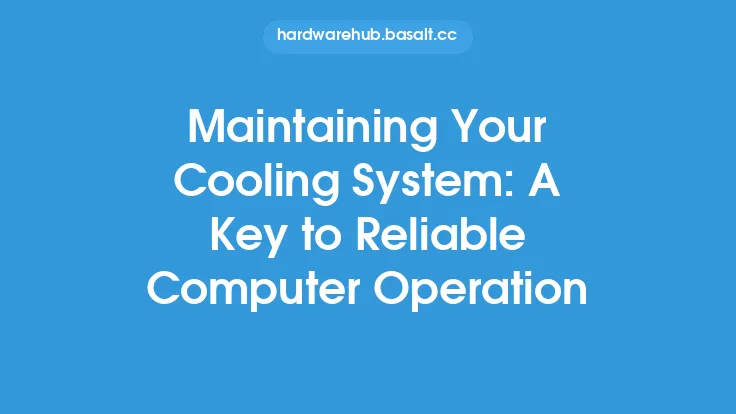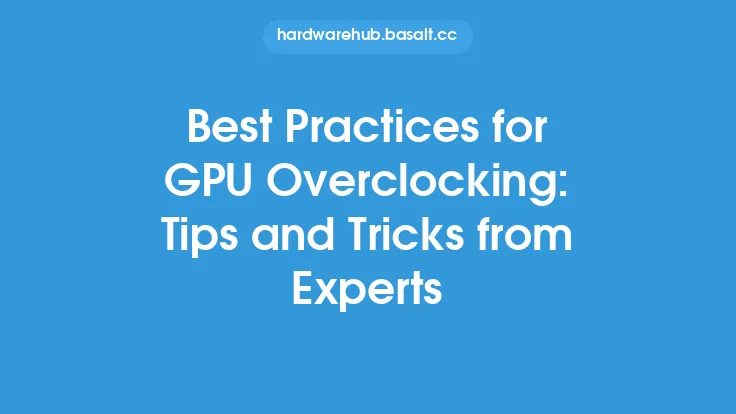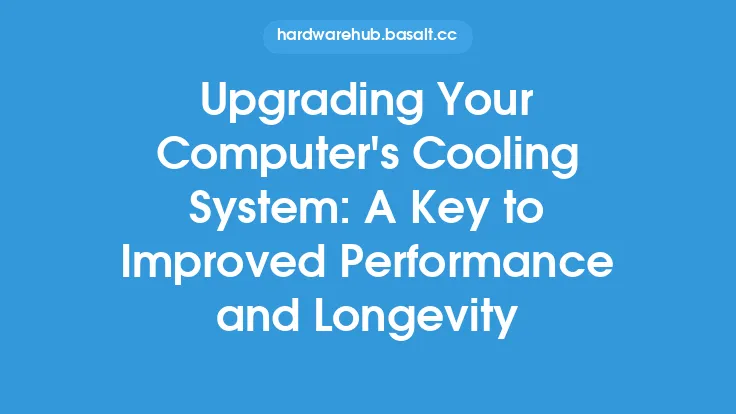To ensure the optimal performance and longevity of your liquid cooling system, regular maintenance is crucial. A well-maintained system not only provides efficient cooling but also helps prevent damage to your computer's components. In this article, we will delve into the tips and best practices for maintaining your liquid cooling system, covering the essential aspects of upkeep, troubleshooting, and optimization.
Importance of Maintenance
Regular maintenance is vital to prevent the buildup of debris, corrosion, and bacterial growth, which can compromise the system's performance and lead to costly repairs. A neglected liquid cooling system can result in reduced cooling efficiency, increased noise levels, and even component failure. By incorporating a maintenance routine into your system's upkeep, you can identify and address potential issues before they become major problems.
Cleaning the System
Cleaning the liquid cooling system is an essential part of maintenance. Start by draining the system and flushing it with distilled water to remove any debris or sediment. Use a soft-bristled brush to gently scrub the radiator, water blocks, and tubing, paying particular attention to areas with visible buildup. Avoid using harsh chemicals or abrasive materials, as they can damage the system's components. For more thorough cleaning, consider using a cleaning solution specifically designed for liquid cooling systems.
Checking and Replacing the Coolant
The coolant is a critical component of the liquid cooling system, and its condition can significantly impact performance. Check the coolant level regularly and top it off as needed. Over time, the coolant can break down and become less effective, so it's essential to replace it periodically. The frequency of replacement depends on the type of coolant used, the system's operating conditions, and the manufacturer's recommendations. When replacing the coolant, make sure to drain the system completely and flush it with distilled water before refilling with the new coolant.
Inspecting and Replacing the Tubing
The tubing is a critical component of the liquid cooling system, and its condition can affect the system's performance and reliability. Inspect the tubing regularly for signs of wear, damage, or corrosion. Check for kinks, bends, or blockages, which can restrict flow and reduce cooling efficiency. If you find any damage or wear, replace the tubing with new, high-quality tubing specifically designed for liquid cooling systems.
Monitoring System Performance
Monitoring the system's performance is crucial to identifying potential issues before they become major problems. Keep an eye on the system's temperature, flow rate, and pressure. Use software or hardware monitoring tools to track the system's performance and receive alerts if any parameters exceed normal operating ranges. This allows you to take corrective action promptly, preventing damage to your computer's components.
Troubleshooting Common Issues
Despite regular maintenance, issues can still arise. Common problems include air bubbles, leaks, and corrosion. Air bubbles can form in the system due to improper filling or temperature fluctuations. To remove air bubbles, try tilting the system or using a bubble-removing tool. Leaks can occur due to damaged or loose connections, so inspect the system regularly and tighten any loose fittings. Corrosion can occur due to incompatible materials or poor maintenance, so ensure that all components are compatible and well-maintained.
Optimizing System Performance
To optimize the system's performance, consider upgrading or modifying components. For example, adding more radiators or fans can improve cooling efficiency, while upgrading the pump can increase flow rate and pressure. However, be cautious when modifying the system, as changes can affect the system's balance and performance. Always follow the manufacturer's recommendations and guidelines when upgrading or modifying components.
Best Practices for Maintenance
To ensure the longevity and performance of your liquid cooling system, follow these best practices:
- Regularly inspect and clean the system
- Check and replace the coolant as needed
- Inspect and replace the tubing as needed
- Monitor system performance and take corrective action promptly
- Troubleshoot common issues promptly
- Optimize system performance by upgrading or modifying components as needed
- Follow the manufacturer's recommendations and guidelines for maintenance and upgrades
Conclusion
Maintaining your liquid cooling system is crucial to ensuring its optimal performance and longevity. By following the tips and best practices outlined in this article, you can prevent common issues, optimize system performance, and extend the lifespan of your computer's components. Remember to regularly inspect and clean the system, check and replace the coolant, inspect and replace the tubing, monitor system performance, and troubleshoot common issues promptly. With proper maintenance and care, your liquid cooling system will provide efficient and reliable cooling for years to come.





